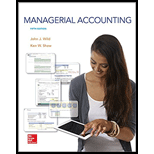
(1)
Introduction:
Liquidity or short-term ratios determines the ability of a firm to pay its current obligations. A good liquidity ration states that the company has liquid assets which can be easily convertible into cash. It includes
To calculate:
Current ratio.
Answer to Problem 4PSB
Current ratio is 2.50:1
Explanation of Solution
= $43,600
= $17,400
= 2.50:1
(2)
Introduction:
Liquidity or short-term ratios determines the ability of a firm to pay its current obligations. A good liquidity ration states that the company has liquid assets which can be easily convertible into cash. It includes current ratio, quick ratio etc.
To calculate:
Acid-test ratio.
Answer to Problem 4PSB
Acid-test ratio is 1.72:1
Explanation of Solution
= 1.72:1
(3)
Introduction:
Days sales uncollected ratio helps the creditors and investors to measure the time in which company collects its account receivable.
To calculate:
Days sales uncollected.
Answer to Problem 4PSB
Days sales uncollected = 18 days
Explanation of Solution
= 18 days
(4)
Introduction:
Inventory turnover ratio measures how many times inventory is sold during a period.
To calculate:
Inventory turnover ratio.
Answer to Problem 4PSB
Inventory-turnover ratio is 15.2 times.
Explanation of Solution
= $15,450
= 15.2 times
(5)
Introduction:
Days sales in inventory calculates the time period which company takes to convert its inventory into sales.
To calculate:
Days sales in inventory.
Answer to Problem 4PSB
Days sales in inventory = 24 days
Explanation of Solution
= 24 days.
(6)
Introduction:
Debt-equity ratio measures the proportion of debt and equity in the capital structure.
To calculate:
Debt to equity ratio.
Answer to Problem 4PSB
Debt to equity ratio is 1.4:1
Explanation of Solution
= $47,400:
= $70,100
= 1.4:1
(7)
Introduction:
Time interest earned ratio measures the amount of income that will be required for covering the interest expenses in the future.
To calculate:
Time interest earned.
Answer to Problem 4PSB
Time interest earned= 6.6
Explanation of Solution
= 6.6
(8)
Introduction:
Profit margin ratio is calculated by dividing net income by the net sales.
To calculate:
Profit margin ratio.
Answer to Problem 4PSB
Profit margin ratio is 7.5%
Explanation of Solution
= 7.5%
(9)
Introduction:
Asset turnover ratio calculates the ability of a company to generate sales with the total assets.
To calculate:
Asset-turnover ratio.
Answer to Problem 4PSB
Asset-turnover ratio = 2.6
Explanation of Solution
= 2.6:
(10)
Introduction:
Return on total asset is a ratio that calculated by dividing earnings before income tax by total assets.
To calculate:
Return on total asset.
Answer to Problem 4PSB
Return on total asset is $0.20
Explanation of Solution
= $0.20
= $23,800
(11)
Introduction:
Return on common
To calculate:
Return on common stockholder’s equity.
Answer to Problem 4PSB
Return on common stockholder’s equity is $0.33
Explanation of Solution
= $0.33:
Want to see more full solutions like this?
Chapter 13 Solutions
MANAGERIAL ACCOUNTING FUND. W/CONNECT
- general accounting questionarrow_forwardHendrix Plumbing Services purchased machinery for $18,400 on March 1, 2022. The machinery has an estimated useful life of 8 years and a residual value of $1,600. Hendrix uses the straight-line method to calculate depreciation and records depreciation expense at the end of every month. As of September 30, 2022, the book value of this machinery shown on its balance sheet will be: A. $17,175 B. $16,800 C. $16,550 D. $18,400arrow_forwardSunshine Bakery, a popular pastry shop, began its operations in 2019. Its fixed assets had a book value of $720,000 in 2020. The bakery did not purchase any fixed assets in 2020. The annual depreciation expense on fixed assets was $60,000, and the accumulated depreciation account had a balance of $120,000 on December 31, 2020. What was the original cost of fixed assets owned by the bakery in 2019 when it started its operations?arrow_forward
- Can you solve this financial accounting problem using appropriate financial principles?arrow_forwardPlease show me the valid approach to solving this financial accounting problem with correct methods.arrow_forwardI need help solving this financial accounting question with the proper methodology.arrow_forward
 Financial Accounting: The Impact on Decision Make...AccountingISBN:9781305654174Author:Gary A. Porter, Curtis L. NortonPublisher:Cengage Learning
Financial Accounting: The Impact on Decision Make...AccountingISBN:9781305654174Author:Gary A. Porter, Curtis L. NortonPublisher:Cengage Learning Managerial Accounting: The Cornerstone of Busines...AccountingISBN:9781337115773Author:Maryanne M. Mowen, Don R. Hansen, Dan L. HeitgerPublisher:Cengage Learning
Managerial Accounting: The Cornerstone of Busines...AccountingISBN:9781337115773Author:Maryanne M. Mowen, Don R. Hansen, Dan L. HeitgerPublisher:Cengage Learning Cornerstones of Financial AccountingAccountingISBN:9781337690881Author:Jay Rich, Jeff JonesPublisher:Cengage Learning
Cornerstones of Financial AccountingAccountingISBN:9781337690881Author:Jay Rich, Jeff JonesPublisher:Cengage Learning EBK CONTEMPORARY FINANCIAL MANAGEMENTFinanceISBN:9781337514835Author:MOYERPublisher:CENGAGE LEARNING - CONSIGNMENT
EBK CONTEMPORARY FINANCIAL MANAGEMENTFinanceISBN:9781337514835Author:MOYERPublisher:CENGAGE LEARNING - CONSIGNMENT



